Jason Polan: From Every Living Person in New York to Every Living Person in Heaven
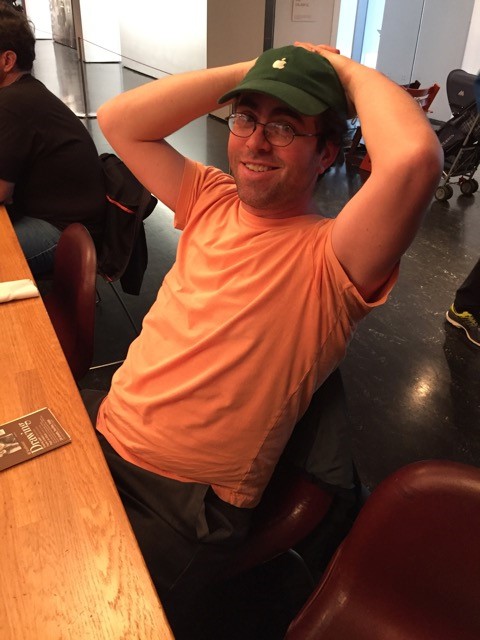
Sadly, Jason Polan, the most prolific artist in New York City, succumbed to cancer on January 27, 2020. He was buried today in Michigan. Before Jason’s life was cut short at age 37, he published numerous books (including the best seller Every Person in New York), drew thousands upon thousands of people, served as the creator of the Taco Bell Drawing Club, was commissioned by large companies for work including Warby Parker (where his book is sold), Uniqlo, and Levi’s. His work has been published in the New York Times, Esquire and Interview.
I met Jason through his aunt and uncle, who are close friends of mine. On a visit to New York in 2016, Jason led his aunt and I on a personal tour of the Museum of Modern Art, an institution where he spent thousands of hours drawing people, coming and going. Those three hours are among the most memorable I’ve ever experienced. It was simply fascinating to observe him as he plied his skill with a Uniball pen and a small note pad, swiftly drawing people who passed by without them even noticing.
On March 29, 2016 I sat down with Jason Polan in the lobby of the Marriott Essex House in New York City. The following is the Q&A conversation we had that day.
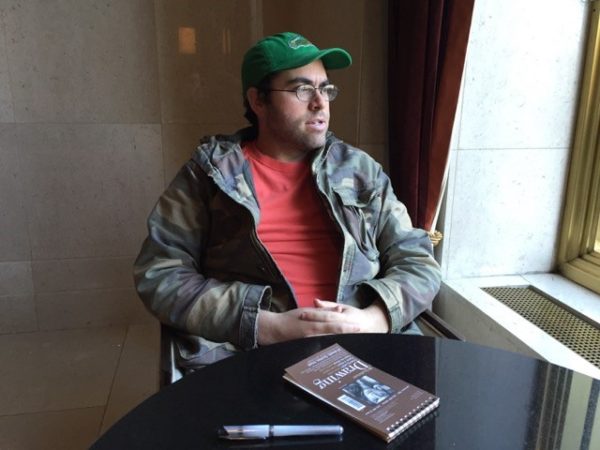
March 29, 2016 Marriott Essex House, New York.
LS: How would you describe yourself? Are you an artist? An illustrator?
JP: I’m an artist. I do a lot of illustration work, but I usually think of the projects I do as art projects.
LS: You published a book (Every Person in New York) which I have a copy.
JP: That’s the only book I’ve done with a major publisher. But I’ve done a couple of books with others like “Dashwood” on Bond Street. And I published some on my own that are staple bound in smaller editions. They were distributed by me through a bookstore called Printed Matter in Chelsea. I’ll sell a few but mostly I’ll mail those to friends.
LS: Can you talk about Every Person in New York, vol. one?
JP: That project started in March 2008. Drawings in that book go to June 2014.
LS: Volume two?
JP: I’m working on it. I want to do them forever. I like the idea.
LS: You’re very observant. You’re a visual person but you also seem to pick up quirks or someone’s personality. I’ve watched you draw quickly. Is that what motivates you?
JP: Yeah, I think we’re kind of rewarded for looking at things and so I’ll see things and I’ll kind of get enjoyment from that. I try to share that with people. So, if I see something that maybe other people aren’t noticing, I’ll draw it and hopefully point it out in a way that other people can enjoy. And, the way I found to do that best for me is to draw. If I take a picture it’s a little quick. But if I draw, I can, maybe, study that thing a little more and focus on it more. So that helps me remember it.
LS: Have you ever been accused of voyeurism?
JP: I will sometimes walk past hotels and I’ll see paparazzi guys, and I’ll be curious who they’re waiting for. I’m often worried that I could come off as a paparazzi to other people because I like drawing famous people. But I’m not really selling that. I like drawing normal people walking down the street as much as I like famous people. So, I don’t think I’m a paparazzi. If I’m looking at someone on a train and they give me a look like, ‘what are you doing?’ I’ll stop because I don’t want anybody to feel uncomfortable with that project. I try to make it a pleasant experience rather than a creepy, sneaky experience.
LS: What do you look for in a subject? A certain personality or type?
JP: I don’t have anything specific that I’m looking for, but I’ll see something and think, ooh I want to draw that. It will be the way somebody’s hair looks or the way their coat is folded, the way they are standing or leaning. There are just certain things that are just slightly out of the ordinary. But there isn’t anything in particular that I’m aiming for.
LS: Can you describe a typical day in the life of Jason Polan?
JP: I usually wake up about 9 ish. I’ll do some emails. I usually have some kind of coffee meeting with somebody. Then I’ll wander around Soho or the MOMA (Museum of Modern Art) for an hour or two. I’ll often go to the post office because I like mailing things and I like getting mail, physical mail. I’ll be meandering most of the day and drawing people. But I don’t have a specific routine. There are several different places I like to hit: bookstores or the post office. I usually get home about 8 pm. Sometimes I’ll scan drawing or work on other drawings.
LS: Do you draw every day?
JP: Yes!
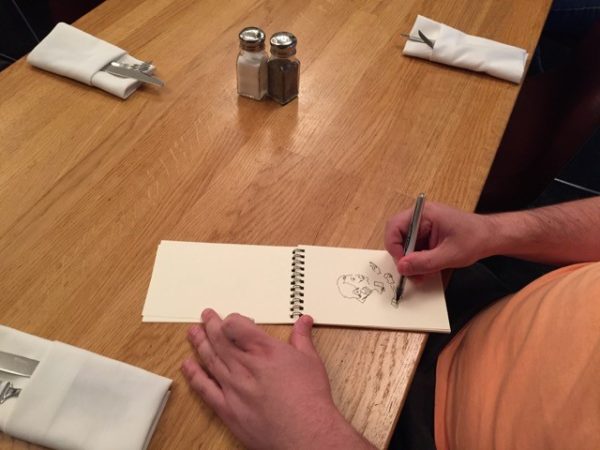
March 28, 2016, Jason Polan drawing at the Museum Of Modern Art, New York.
LS: Do you keep all your work?
JP: I usually draw on notepads (4×6 Strathmore drawing paper pads). And I have stacks of these that I go through. I usually go through one of these books a week. And there are about 24 pages long. Often, they just have lists and notes.
LS: Do you always draw with a pen?
JP: I use a Uniball Vision Elite bold black pen. It has a thick line that I like.
LS: When you are drawing people, do they ever ask, ‘Can I have that?”
JP: Usually when I’m drawing people they don’t notice that I’m drawing them. I like it more if they don’t know because it’s a little more natural. When people know I’m drawing them they have a certain posture, or they’ll be expecting something. That makes me nervous. But every once in a while, somebody will notice, and I can just give them the drawing. But, when people ask me to draw them, I don’t, because it’s not a natural experience for me. I did a project in San Francisco a couple of years ago that was for Levi Jeans. It involved drawing people on a big structure. Some people would come up and want me to draw them.
LS: Was it a mural?
JP: Yes. It was the shape of a building with white blocks. It was a month-long advertisement for Levi’s. People would come up to me while I was drawing, and I realized that people could see the drawing while I was making it. I could tell if people liked it or if they were let down by the drawing. I didn’t like that.
LS: How much of your work is commissioned for commercial purposes?
JP: Every Person in New York is my project, but it’s led to other things.
LS: Were you hired by companies after they saw your work?
JP: I’ve done a bunch of personal projects that led to connecting with art directors at various companies.
LS: Can you name a few?
JP: I’ve worked with Nike, GAP, and the Ford Foundation. I draw for the Audubon Society and Warby Parker. I like doing physical things like making a drawing then it exists on a t-shirt or limited-edition prints. I’ve done a bunch of drawings for the New York Times, Esquire Magazine, and Interview Magazine.
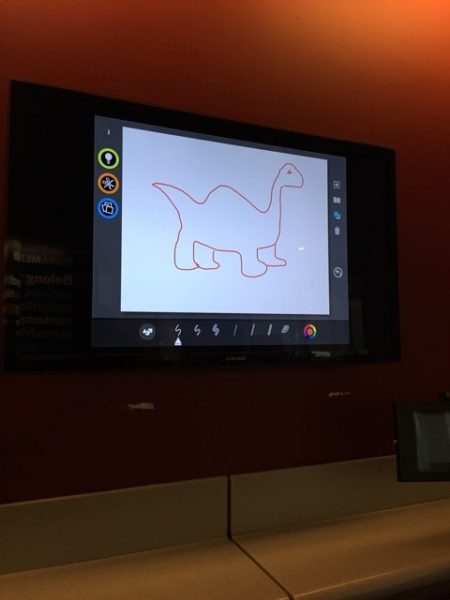
March 28, 2019, Dinosaur drawn by Jason Polan, Museum of Modern Art, New York.
LS: You’re very busy Jason Polan. When you are working for someone else, do they set the boundaries, or do you?
JP: I’ve been pretty luck. A lot of art directors will know what I do so they’ll want something similar. Usually they’ll assign me work that fits with what I do. But there are times when there is a back and forth with the art directors. I like collaborating with people who are smart.
LS: You went to art school. Did you always want to be an artist?
JP: I’ve always drawn. I went to the University of Michigan for anthropology and drawing and painting. I’ve always wanted to do something art-related
LS: Did you grow up in a house with art?
JP: Yes. My Mom has really good taste in art. Both of my parents have been really supportive of me and my siblings and encourage us. I’ve been lucky that I’ve always liked art and have been able to continue to do that.
LS: How does the study of anthropology tie into your work?
JP: I studied biological anthropology which is kind of the way our bodies have changed over time. I was initially attracted to that because there is a really good anthropology department at U of M. The lab had a lot of bones. So, I was drawing a lot of evolutionary skulls. I was drawing our bones as they have changed over time and so I continued to do that. That’s how it is related to my art.
LS: Do you have a favorite subject matter to draw? Do you find yourself going back to certain things?
JP: There are different parts of faces I like to draw. There are definite subjects like the angles of people’s hands that I’m attracted to. Something I’ve been doing a lot lately is that I paint on fruit. I’ll paint with watercolors. I’ll slice a pear and then I’ll paint it. It’s just an abstract color thing. But I really like painting things that are a little weird.
LS: Does the paint run?
JP: Yes, that’s part of it. It bleeds a lot, so I use watercolor with less water than usual because it’s already wet. But it holds the color nicely. Then I’ll take a picture of it and it won’t exist other than that picture. I usually eat the fruit after I slice off the watercolor edge. I’ve been doing a lot related to food because I spend a lot of time with food. I have friends who do a magazine called “Lucky Peach.” So that’s the influence and direction I’m going.
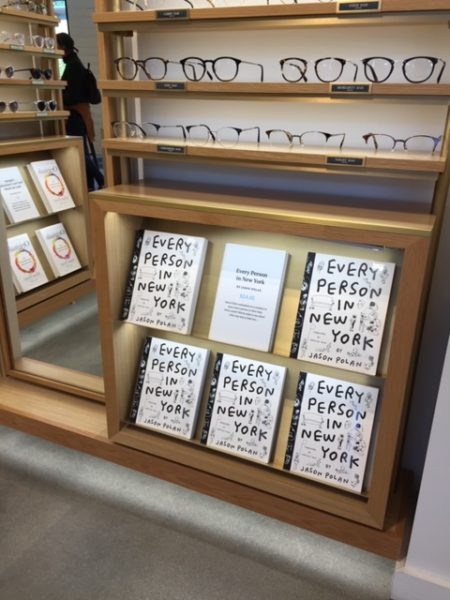
May 12, 2019, Jason Polan’s book, Every Person in New York, for sale at Warby Parker, Sacramento, CA.
LS: Where do you see yourself in five years?
JP: I don’t know what I’ll be doing in five years. I’m pretty happy with the projects I’m doing now, but I want to continue to get better.
LS: Is NYC the place you must be to create the kind of work you do? Could you draw in any other city?
JP: I have this project where I’m forcing myself to be in NYC. But a lot of the illustration work I do, I can do anywhere. There are a lot of magazines where the people I interact with, I’ve never actually met in person. So, I could draw anywhere, then scan them and send them electronically. But I do appreciate the quantity of people that are here in New York. When I’m in other cities, I won’t be able to draw as many people.
LS: Do you feel like you blend in with crowds. Are you anonymous when drawing?
JP: Yes. But I’m always excited to see a celebrity and I’ll often try to have some kind of interaction with them. I want to see if they’re a nice person. Here, in New York, I’ve found that celebrities walk around among us normal people. It’s a cool thing not to bother celebrities.
LS: Who have you seen recently?
JP: I saw Neil de Grasse Tyson yesterday. And I saw Jonah Hill walking down the street. It’s funny most of my drawing of celebrities are from behind because I’ll see them and then it will take me a second to get my pad out and then draw them as they’re walking the other direction.
LS: Has anyone gotten angry with you?
JP: I’ve been lucky that nobody has been angry with me. But sometimes there will be comments on the internet. I’ve been lucky that nobody has punched me. But I’m coming at it very passively. If I feel like I’m invading someone’s space, I’ll just stop.
LS: If you weren’t an artist, what would you do?
JP: I don’t know. May be a masseuse.
LS: There you go with the body again. Have you ever created sculpture or worked with clay?
JP: Yes. I’ll make sculptural things. I often make things that are smaller, even just drawings: maybe 8×10 busts of people or little animals for gifts, tchotchkes.
LS: Are your friends also artists?
JP: Some are artists, some are writers. I know a lot of photographers. Yes, mostly arty friends.
LS: Do you have a place, like Nights of the Round Table, or a bar, where you hang out? Like a power lunch club?
JP: Usually Taco Bell. I do this thing called the Taco Bell Drawing club. We meet every week. I started it here in NYC about 11 years ago. We usually meet at the one near 14th Street. I invite people to come draw with me. There are over 300 members around the country. But the one here in NYC has just two or three people and me. It’s been a fun excuse to get together with people. If I’m in NYC on Wednesdays, we’ll meet here. But if I’m out of town, I’ll try to do it wherever I am.
LS: Do the people at Taco Bell know you are doing this?
JP: The people who work at Taco Bell don’t. But I’ve had some contact with corporate Taco Bell, and they are aware.
LS: Have they offered you any work?
JP: Yes. I’ve done a little bit for Taco Bell.
LS: Do you get free Taco Bell tacos for life?
JP: I wish. They held a Thanksgiving event where they served Taco Bell food in their offices. I made the menu for it. It was kind of a funny project. I’ve done a couple of other things for them. I like Taco Bell a lot.
LS: Have you done any teaching?
JP: Only if a friend is a teacher. I’ll go in and do a class, but I haven’t done anything too elaborate.
LS: Do you have a mentor?
JP: There was a writing teacher of U of M that I really liked: Fritz Swanson. And, we still do a lot of projects together. He introduced me to a lot of the writers that I like a lot.
LS: What sort of projects?
JP: He runs a letterpress now, so I’ll do drawings and he’ll print them. It’s a collaborative thing. We also both have backgrounds in comic books, so we have similar tastes in certain things.
LS: Any in particular?
JP: There’s an artist named Jerry Panther that I like a lot who does a lot of comics. But when I was younger, I liked the usual: Spiderman.
LS: Do you mentor anyone?
JP: Not really. When people email me with questions, I try to be helpful.
LS: Do you put your drawings on social media?
JP: Yes. I have a website: everypersoninNewYork.blogspot.com
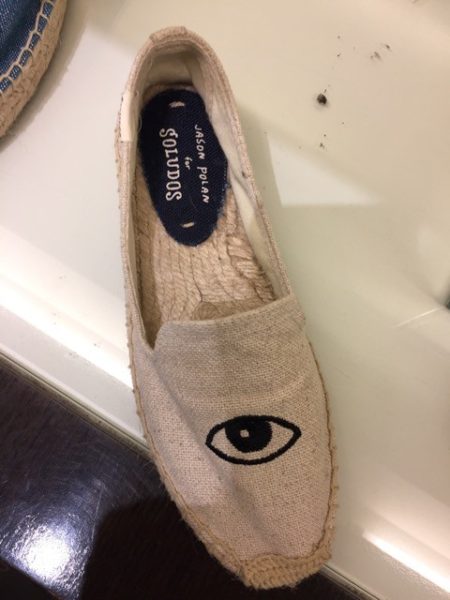
October 6, 2017, Soludos featuring a design by Jason Polan, for sale at Nordstrom, San Diego, CA.
LS: You’re so low key. I can see how you can easily sit in public places and draw because you blend in.
JP: You mean because I’m wearing camouflage right now? I did an interview for a lady with a German newspaper and when we met, she made a comment, ‘I expected you to look different.’ I guess she expected me to look artsy or something. Yes, I don’t like standing out at all. And it’s definitely helped me with my projects. I don’t want anybody to notice what I’m doing.
LS: Have you received media attention?
JP: There was a video segment on ABC News showing me walking around 14th Street that appeared on Yahoo’s main page. After that, my website got 30,000 hits that afternoon. It was crazy.
LS: Is that your neighborhood?
JP: I live in West Soho. But I hang out around Union Square. I like going to the Strand Bookstore.
LS: Who is your target audience?
JP: I don’t think I have one. I want to reach everybody. I like the idea of doing children’s books, but I also like doing things that are entertaining to adults.
LS: Are you drawing for others to see your work, or for your own satisfaction?
JP: Both. I enjoy drawing while I’m doing it, but I also feel good when other people enjoy what I do. Sometimes there is a hesitation by an artist to do something for somebody else. But I don’t feel that. I like quantities and I like other people to see the things I make. So, I’m okay with that.
LS: Artists are often influenced by politics or war. Are these, or other topics, behind your art?
JP: I don’t do work in response to that too much. I’ll try to make light of some things like the recent political stuff. Just thinking about Donald Trump: Six years ago, I drew him during an event at Rockefeller Center. He walked by and I drew him. I usually don’t do things that have that kind of heaviness to them. It’s not that I’m not experiencing them, it’s not something I would be able to express properly.
LS: So then, your work is intentionally light?
JP: Sometimes I’ll draw things that I think are sad but, I think that’s because I want to. I can relate to the person because we’re not always happy all the time. But there is this funny vibe I get on Instagram from people’s comments: ‘Well I wish I had your life,’ or ‘This is so fun all the time.’ And I’ll think, I’m not pushing the times when I’m sad. The internet has a certain vibe and I don’t want to make people sad. Mostly I want people to be happy. So that’s my end goal.
LS: Thank you for your time and honesty.


